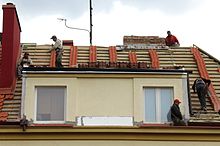Fall protection (human)
Under fall protection is meant practices and devices that serve a crash to avoid the stay or during activities in areas where a crash due to the possible fall height to injury can result.
Different types of fall protection are used depending on the area:
- In construction , fall protection is understood to mean a component that enables the user to move safely on surfaces that are not on the ground, such as a parapet or a grating or railing . (see also: Fall-proof glazing )
- In the area of occupational safety, temporary fall protection measures such as scaffolding, provisional railings, safety nets, safety ropes or covers are used. Fixed attachment points (anchors) for inspection and maintenance can be planned on flat roofs .
- When climbing securing fall protection is generally effected by a rope , with the Express sets in intermediate anchors is suspended and a backup partner , which is responsible for the fall of the climber with the aid of a securing device to intercept. If the belaying partner himself is also in a terrain at risk of falling, he is fixed at a stand .
- In the fire service , fall protection is regulated by fire service regulation 1. The "fall protection set" (see below) - and, in an emergency, the fire brigade lanyard and the fire brigade harness - is primarily used.
- So-called lifebelts are used on sports boats to prevent falling overboard. On large sailing ships, sailors wear fall protection devices when they have to climb into the rigging .
- In gymnastics and artistry , for example in variety , acrobats are secured from falling by holding on directly or by means of various types of lungeing. Figures like somersaults at hand height can still be held directly or secured with a handlong, a belt with short ropes on the sides. Higher figures are secured with a simple pulley system attached to the ceiling . These lunge straps still have suitable straps for the respective exercises. For screws , for example, there are belts with ball bearings so as not to hinder the rotation.
While the fall protection in construction is firmly attached to the danger point in order to protect anyone from falling at this location, the fall protection is carried by the user when climbing and at the fire service and is intended to protect him at any possible fall point. Example: energy absorber . In the construction industry, where the installation of fixed safety devices would not be possible or would be disproportionate - for example during roofing work - the persons assigned to do so wear safety harnesses that allow securing with a rope.
DIN EN 795 Protection against falls - Anchor devices - Requirements and test methods is decisive for the calculation of attachment points for fall protection .
Fall protection equipment set
The fall protection equipment set is an aid for fire brigade work in areas at risk of falling and has been in DIN 14800-17 since May 2007 (revised November 2015). The equipment set includes a core sheath dynamic rope , various snap hooks , various belt slings , gloves , a full body and seat belt and a close-range safety device in the form of a lanyard with an integrated energy absorber (Y-sling). The set can optionally be supplemented with a class B rescue loop (rescue triangle with shoulder strap).
In some cases, so-called fall protection sets with minimal equipment (complete harness, carabiner, sling and kernmantle rope) are still in use at the fire services. These often originate from times before the fall protection equipment set was standardized. The fall protection equipment set is stored in a transport sack with rucksack straps (duffel bag) that must fit into a box in accordance with DIN 14880. The equipment set may only be used by personnel who have been trained in theory and practice.
See also
Web links
- Germany: Professional association regulations and rules of the professional association raw materials and chemical industry
- Switzerland: Construction Work Ordinance, BauAV
- Austria: Construction Worker Protection Ordinance
- DIN EN 795 | 2012-10: Personal fall protection equipment - anchor devices
Individual evidence
- ↑ DIN 14800-17, Fire Brigade Standards Committee (FNFW) in DIN, May 2007.

